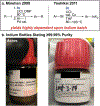Origins of Batch-to-Batch Variation: Organoindium Reagents from Indium Metal
- PMID: 33692605
- PMCID: PMC7943174
- DOI: 10.1021/acs.organomet.0c00417
Origins of Batch-to-Batch Variation: Organoindium Reagents from Indium Metal
Abstract
Yields of organoindium reagents synthesized from indium metal were previously reported to be highly dependent on metal batch and supplier due to the presence or absence of anticaking agent. Here, single-particle fluorescence microscopy established that MgO, an additive in some batches nominally for anticaking, significantly increased the physisorption of small-molecule organics onto the surface of the resulting MgO-coated indium metal particles. An inert and relatively nonpolar boron dipyrromethene fluorophore with a hydrocarbon tail provided a sensitive probe for this surface physisorption. SEM images revealed markedly different surface properties of indium particles either with or without MgO, consistent with their different physisorption properties observed by fluorescence microscopy. We further documented incomplete commercial bottle labeling regarding the presence and composition of this anticaking agent, both within our laboratory and previously in the literature, which may complicate reproducibility between laboratories. Trimethylsilyl chloride pretreatment, a step employed in a subset of reported synthetic procedures, removed the anticaking agent and produced particles with similar physisorption properties as commercial batches of indium powder distributed without the anticaking agent. These data indicate the possibility of an additional substrate/catalyst physisorption mechanism by which the anticaking agent may be influencing synthetic procedures that generate organoindium reagents from indium metal, in addition to simple anticaking.
Conflict of interest statement
The authors declare no competing financial interests.
Figures




References
-
- Baker M; Penny D Is There a Reproducibility Crisis? Nature 2016, 533, 452–454. - PubMed
-
- Lauer M Authentication of Key Biological and/or Chemical Resources in NIH Grant Applications. NIH Extramural Nexus [online] 2016, https://nexus.od.nih.gov/all/2016/01/29/authentication-of-key-biological... (accessed May 29, 2020)
-
- National Institutes of Health. Reminder: Authentication of Key Biological and/or Chemical Resources, NOT-OD-17–068, 2017.
Grants and funding
LinkOut - more resources
Full Text Sources
